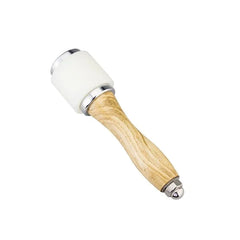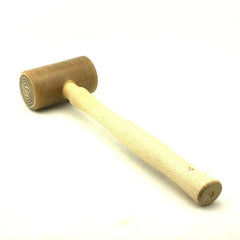Using Mallets and Mauls for Leathercraft
Antonia MarinoAs you start on your leathercrafting journey, you'll quickly realise the importance of having the right tools. Among these tools are mauls and mallets, both essential for various tasks in leatherwork.

A maul is a heavy hammer, with a weight typically ranging from 16 to 32 ounces but can go up to 70+ ounce. The weight of the maul provides the necessary force for tasks such as stamping, setting rivets, and pounding seams.
For beginner leathercrafters working on small projects like wallets and keychains, a maul with a weight between 16 to 24 ounces is a good start. This weight strikes a balance between providing sufficient force and being manageable for precise work.
Mauls come in various shapes and sizes, but most feature a cylindrical head on which you strike on the curve. The head is often made of dense rawhide or poly, which ensures durability and longevity. Mauls are very well balance, providing consistent strikes.
When using a maul, hold it firmly but not too tightly to maintain control over your strikes. Practice makes perfect when striking on a curved surface, but once you get the hang of it you will find accuracy much easier to acheive than with a mallet.
A 16 oz. maul is great for delicate work, a 24 oz. strikes a balance between versatility and fatigue. A 1-1/2 to 2 lb. maul is for power and accuracy. And a 32 oz. to 3 lb. maul for strap end punches and the like.
Unlike mauls, mallets have a softer striking surface, making them ideal for tasks that require gentler force or when working with softer leather types. Like mauls, the heads of mallets are typically cylindrical but you strike on the flat ends of the head. Mallets are available in different materials, including rawhide, rubber, bakelite, poly, wood and plastic.

Rawhide mallets are popular among leathercrafters due to their ability to deliver a controlled impact without damaging the leather surface. For beginners, a rawhide mallet weighing around 8 to 16 ounces is suitable for tasks such as tooling, embossing, and shaping leather. The lighter weight allows for greater precision and reduces the risk of inadvertently applying too much force. A heavier option is ideal for setting copper or tubular rivets.
Poly mallets are budget-friendly and come in a range of weights and sizes. The 9 oz. poly mallets are great for rivet setting, stamping, and tooling. If you need a bit more oomph, go up a size or two. The best thing about poly mallets are their durability and versatility.
Tips for Beginners:
- Practice Proper Technique. Hold the hammer with a relaxed grip and focus on accuracy rather than force. Practice controlled strikes on scrap leather to get a feel for it and to avoid damaging your workpiece.
- Choose the Right Tool for the Job. Consider the type of leather you're working with and the specific task at hand when selecting between a maul and a mallet.
- Invest in Quality: While it may be tempting to opt for budget-friendly options, investing in high-quality tools will pay off in the long run with improved performance and durability.

